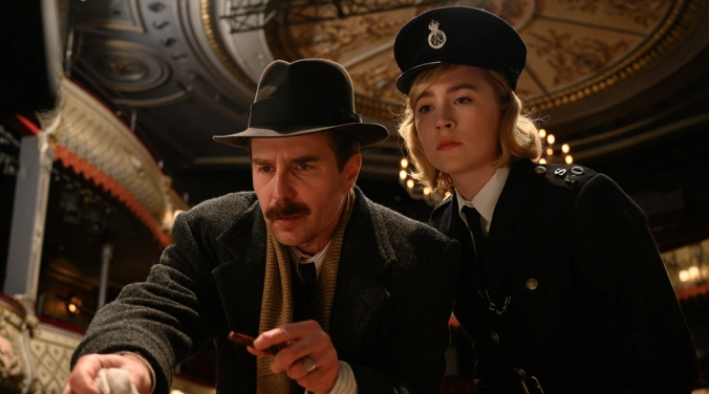Film Review: “See How They Run”
A performance of Agatha Christie’s long-running stage smash “The Mousetrap” yields a backstage murder mystery of its own in this most enjoyable all-star comedy.
by Amy Nicolson
Agatha Christie, master of deduction, was wrong only once. When her play “The Mousetrap” opened in London in 1952, she reckoned it would last eight months. 70 years later, the unkillable production lives on — even Covid only clipped it for 14 months — and yet, the actual plot of the longest-running show in theater history makes most people draw a blank. This is due to two clauses in Christie’s contract: First, every night, the actors order the audience to keep the story secret, and second, every movie producer who wants to turn the play into a film is told they must wait until the end of its run, which at this point may be never.
Yet, debut director Tom George (of the BBC sitcom “This Country”) and screenwriter Mark Chappell have cleverly cracked the code. “See How They Run,” a snappy comedy that struts in with an eyebrow coyly arched, stages its own murder mystery on the backstages of this backstory. The intrigue starts in 1953, when sleazy Hollywood filmmaker Leo Köpernick (Adrien Brody) is strangled on the night of “The Mousetrap’s” hundredth performance. “I should have seen this coming,” Köpernick’s ghost narrates drolly. After all, he’s the crass American who irritated the play’s cast and crew by arguing that his version would open with a violent slaying — and insisted that said victim would be the plot’s most unlikable character, who turns out to be him.
To find the murderer, the Scotland Yard duo of Inspector Stoppard (Sam Rockwell), a jaded drunk, and Constable Stocker (Saoirse Ronan), a greenhorn itching to slap handcuffs on anyone who glowers, must investigate Köpernick’s many moral failings and enemies. There’s the aggravated screenwriter Melvyn (David Oyelowo), who wished him dead. There’s “The Mousetrap” star Richard Attenborough (Harris Dickinson), whose appearance is historically half-accurate (Attenborough did originate a lead role in the production) and half-fictionalized (he did not angrily push a Hollywood director into a four-tier cake). Other suspects considered Köpernick a heartless lover, a wastrel father, a blackmailer, a fool and a creep. Yet, paramount among his crimes, as far as the film is concerned, is that even in death, Köpernick’s ghost continues to sneer that murder mysteries — even his own — are boring. As his ghost groans, “Seen one, you’ve seen ‘em all.”
Gauntlet thrown. “See How They Run” is a retro homage that surprises audiences with giggles and suspense. Chappell’s script pits old-fashioned Christie-style chills against the hip gunplay that Köpernick claims will excite Eisenhower-era squares. (Köpernick’s ideas are destined to become the action flick status quo.) In flashbacks, he pitches his take on updating the whodunnit to the unswayable Melvyn (David Oyelowo), a traditionalist who clings so stubbornly to the past that he still pronounces the word “penchant” as though he believes it’s 1066 and England’s official language is French.
While the real-life London producers of “The Mousetrap” credit its perennial success to the fact that it’s performed without a drop of irony, George and Chappell give their cast’s deadpan line deliveries a light layer of modern gloss. We’re meant to snort at the subtext when Melvyn introduces his live-in Italian lover (Jacob Fortune-Lloyd) as his, er, nephew, or chuckle when a police commissioner (Tim Key) declares himself a feminist modernizer, and then asks Ronan to fetch him a tea.
Sometimes, the joke is on “The Mousetrap” itself, which is presented as stiff and stagey. Whenever any of the film’s characters attempt to sit through it, they quickly make excuses to leave. A better Wile E. Coyote-style gag takes place in the wings, when a person in peril attempts to fend off the killer by flinging ceramic vases, which turn out to be plaster props that crumble harmlessly. Mostly, though, George and Chappell enjoy watching these artistic hotheads bicker about their differing story-telling philosophies, debates that allow the filmmakers to pluck sample gimmicks — time stamps, close-ups of pistols, country house clichés — and re-insert them into their own movie as a meta-prank.
As the plot quickens, editors Gary Dollner and Peter Lambert divide the screen into two pieces, then three, then four. Their cutting is brisk and fanciful, and, during a standout dream sequence, marvelously illogical. Meanwhile, composer Daniel Pemberton unleashes a jazzy upright bass to climb up and down the scales.
Still, the film is firmly in the pocket of Rockwell and Ronan as the odd pair working to solve the carnage. Rockwell’s shambling detective is all kinetic energy: He drinks, he limps, he slams his coat in car doors, and at one point, skids to his knees. Ronan is so aquiver with nervous excitement that she continually chokes out nonsensical lines that zoom almost under the radar. (She explains that she quit her secretary career for the police academy because she “hates the sight of blood.”) George gets Ronan in such a tizzy that we are poised to see her panic just from the snap of a pencil tip.
Despite Rockwell and Ronan’s hilarious turns, they’re nearly outshone by a small cameo from Shirley Henderson playing the great Dame Agatha herself, who becomes tangled in this web of lies and fools. At last, Christie has an opening to prove she can save her own neck. But what she does, how she does it, and whether it works is a mystery best to discover on the screen.


Comments are closed, but trackbacks and pingbacks are open.